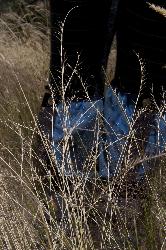- Taxon
- Weed
- Gallery
Stiff, dense, bright green or greyish green perennial tufts, 15–30–(40) cm, from shortly creeping rhizome, sometimes forming large swards; branching intravaginal. Leaf-sheath coriaceous, strongly ribbed, glabrous, shining, pale greyish brown or creamy. Ligule 0.5–1.4 mm, truncate, entire, abaxially with sparse prickle-teeth. Leaf-blade 6–18 cm ×c. 0.5 mm diam., tightly involute, hard, pungent, spreading at right angles to sheath at maturity, abaxially smooth, or with minute prickle-teeth or hairs beside ribs, adaxially minutely papillose on ribs. Culm 10–32 cm, slender, erect, internodes glabrous, or minutely hairy or prickle-toothed. Spike 4.5–7.5 cm, secund, very slender; rachis concave-convex, smooth but margins finely scabrid, produced as a fine scabrid bristle 2–9 mm. Spikelets 6–10.5 mm, 1-flowered, in 2 rows along concave side of rachis, loosely to closely overlapping, sessile in notches on rachis, green or usually purplish. Glumes persistent, much reduced; lower a ± triangular, sometimes short-ciliate wedge, projecting upwards from rim of rachis-notch, c. 0.3–0.6 mm, upper usually 0. Lemma = spikelet, 3-nerved with central nerve inconspicuous and lateral nerves prominent, subcoriaceous with wide membranous margins, narrow-lanceolate or lanceolate-oblong, smooth to minutely scabrid above with some longer prickle-teeth on lateral nerves; awn 1.6–3 mm, terminal, straight. Palea slightly < lemma, membranous, apex rounded and very short-ciliate, keels 2. Callus ringed by minute hairs. Lodicules 0. Stamens 3; anthers 3.5–4 mm and fertile, or mostly 1–2 mm and pollenless. Gynoecium: ovary c. 1 mm, glabrous; stigma-style 5–6 mm. Caryopsis c. 3 × 0.5 mm, fusiform; embryo c. ⅙ caryopsis; hilum c. ⅓ caryopsis. Fig. 4.
[From: Edgar and Connor (2000) Flora of New Zealand. Volume 5 (second printing).]




